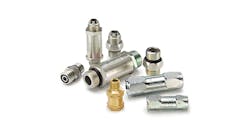Parker Hannifin check valves used as fuel pressure regulators
Truck engine manufacturers continue to face more stringent requirements than ever related to efficiency and emissions. As a result, the pursuit of new ideas and technologies to meet these challenges is ongoing. Once such new solution for fuel regulation for Class 7 and 8 vehicles is using check valves as fuel pressure regulators.
“This is a key development we’ve been seeing because in a fuel delivery system, fuel regulation is critical,” said Cameron Koller, market development manager for Parker Hannifin’s Quick Coupling Division. “It’s important because check valves acting as fuel pressure regulators are helping OEMs meet Tier 4 compliance, which is the most recent engine emissions standard implemented by the Environmental Protection Agency.”
Read more: EPA’s new HD emissions rules push manufacturers and fleets to plan aheadIt’s common for engine manufacturers to use a check valve, sometimes called a one-way valve, to allow the flow of fluids to move in only one direction. These valves are found in almost every mobile and industrial hydraulic system. If there's a pump, you'll likely find a check valve that’s preventing backflow from damaging upstream componentry.
But in addition to performing this important function, check valves are now flexing their versatility by taking on responsibilities they weren’t actually designed for. OEM engine manufacturers are now using Parker check valves as fuel pressure regulators in their Class 8 trucks. These trucks include many big rigs that weigh more than 33,001 lbs. as well as heavy-duty construction vehicles like cement and dump trucks.
For these vehicles, the check valves aren't just controlling the direction that fuel is flowing but controlling the amount of fuel delivered to the engine.
Signed in 2004, Tier 4 emissions standards were phased in from 2008 to 2015. The goal with Tier 4 was to significantly reduce nitrogen oxide (NOx) and particulate matter (PM) emissions.
Acting as fuel pressure regulators, check valves can ensure that the pump in the fuel system is not injecting too much or too little fuel into the engine, regulating a steady, precise amount of fuel to avoid pressure imbalances, which provides greater operational efficiency and helps avoid emissions issues.




